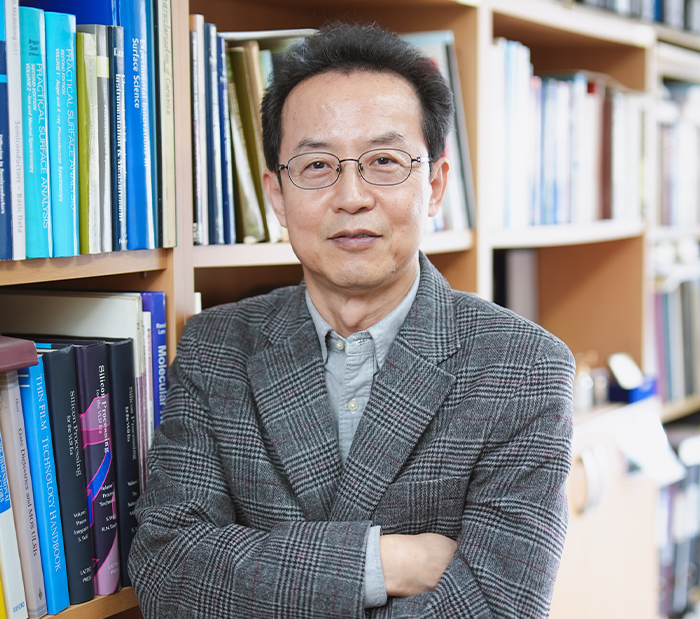Predicting and demonstrating of hidden metastable phase in transition metal oxide
Advanced Materials Science and Engineering LEE, JAICHAN Prof. · Bongwook Chung

-
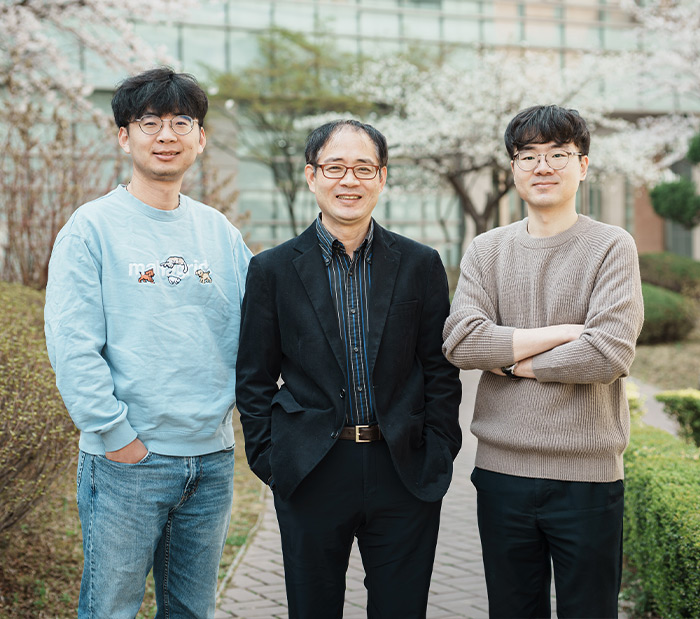
Chemistry LEE, JINYONG Prof. ·Dr. Hao Li and Dr. Jong Hyeon Lim
Graphynes and Graphdiynes for Energy Storage and Catalytic Utilization
Prof. Jin Yong Lee (Department of Chemistry) and his research team, including Dr. Hao Li and Dr. Jong Hyeon Lim (co-first authors) and Prof. Baotao Kang (University of Jinan, a doctoral student under Prof. Jin Yong Lee's supervision), published a theoretical studies on the application of the Graphyne and Graphdiyne (GDY) materials in various energy storage and catalytic utilization fields in Chemical Reviews (IF: 72.087) on April 26, 2023 under the title "Graphynes and Graphdiynes for Energy Storage and Catalytic Utilization: Theoretical Insights into Recent Advances." This paper explains the structural, optical, and electronic properties of the Graphyne family from the perspective of theoretical chemists. It particularly focuses on the diverse applications of GDY-based materials, which are the only experimentally reported members of the Graphyne family. Various carbon allotropes have made significant contributions to humanity with their unique and outstanding properties. Among them, Graphyne materials, as carbon-based low-dimensional substances, possess excellent physical and chemical characteristics, making them suitable for a wide range of potential applications. Especially, GDY is the only synthesized member and has garnered practical applications in various research fields, such as energy storage and catalytic utilization, due to its large surface area, sp/sp2 hybrid orbitals, and a consistent band gap. However, most of the Graphyne family has only been studied theoretically, and there are still many unsynthesized Graphyne members. Therefore, the diverse theoretical and experimental results covered in this paper can provide important insights not only to researchers in the theoretical field but also to experimental researchers, stimulating more collaborative research between theory and experiments. Efficient development of energy storage materials and catalysts is essential for addressing the global energy crisis. In this field, GDY is a promising material for various energy technologies, including electrocatalysis, photocatalysis, solar energy conversion, hydrogen storage, ion batteries, and supercapacitors. However, research on graphyne-based materials remains limited due to the lack of synthesis. This paper suggests potential applications in the field of energy materials by investigating the structure and electronic properties of graphyne through research. In the past decade, Prof. Jin Yong Lee has published dozens of papers on this topic in journals such as Chem. Eng. J., Energy & Environ. Mater., Carbon, App. Surf. Sci., Phys. Chem. Chem. Phys. *Title:Graphynes and Graphdiynes for Energy Storage and Catalytic Utilization: Theoretical Insights into Recent Advances
- No. 222
- 2023-05-31
- 2061
-
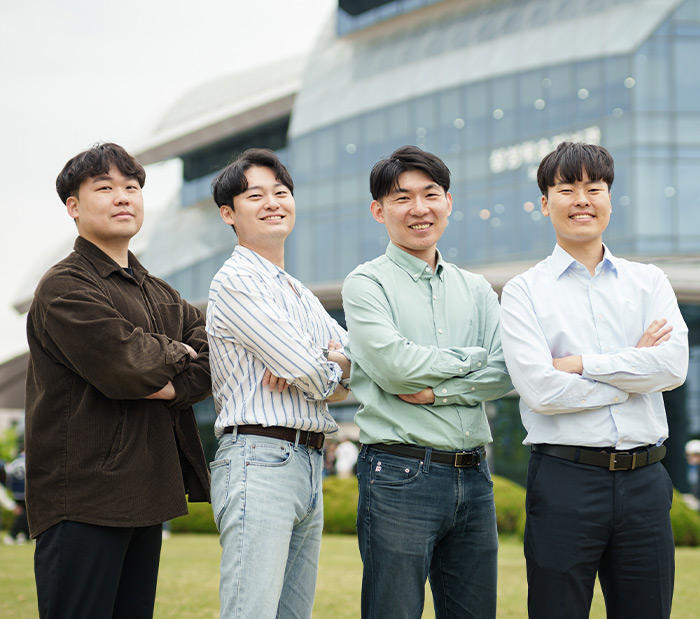
Bio-Mechatronic Engineering PARK, JINSUNG Prof.
Detection of the ultra-sensitive presence of perfluorooctanoic acid (PFOA)
Professor Jinsung Park's research team has achieved a groundbreaking feat by successfully detecting the ultra-sensitive presence of perfluorooctanoic acid (PFOA) using self-assembled p-Phenylenediamine* nanoparticles (SAp-PD). This marks the first-ever application of SAp-PD nanoparticles for detecting PFOA, which is generated during the cooking process of Teflon-coated frying pans. The team's remarkable accomplishment was published in the esteemed international journal "Journal of Hazardous Materials," known for the top 3% in the field of environmental science. *p-Phenylenediamine(p-PD) : It is an organic compound that is one of the ingredients in dyes, possessing an amino group (-NH2) at both ends. It typically exists as a white powder at room temperature, but it exhibits a characteristic reddish-brown color when oxidized in an aqueous solution. PFOA, widely employed across various industries for its surfactant properties, heat resistance, and non-stick characteristics, has particularly found extensive use as a coating agent for cooking utensils such as frying pans. However, its classification as a Group 2B carcinogen by the International Agency for Research on Cancer (IARC), a subsidiary of the World Health Organization (WHO), has led to restrictions on its utilization. The detection of elevated levels of perfluorinated compounds in Daegu's tap water in 2018 further intensified the significance of detecting PFOA with high sensitivity. The research team employed Raman spectroscopy, a technique that detects and analyzes unique spectral patterns produced when examining specific laser wavelengths on materials. Each substance possesses its distinct spectrum, analogous to individual fingerprints. To maximize the Raman signal, they incorporated the Surface Enhanced Raman Spectroscopy (SERS) method, which relies on the nanostructure of the substrate to enhance the analysis. In this study, the team utilized a silver nanograss substrate, on which they measured the variation in Raman intensity of SAp-PD—exhibiting its own distinct Raman spectrum—before and after exposure to PFOA. . In a significant scientific breakthrough, research team have developed an ultra-sensitive detection sensor technology for perfluorooctanoic acid (PFOA) by harnessing the unique properties of p-Phenylenediamine (p-PD). When p-PD is present in an aqueous solution, it gradually undergoes oxidation over time, transforming into self-assembled spherical nanoparticles while exhibiting distinct Raman spectra. However, when p-PD interacts with PFOA, the nanostructure undergoes collapse, leading to a reduction in Raman spectrum intensity. Leveraging this mechanism, the team successfully developed a pioneering technology for detecting PFOA with exceptional sensitivity, marking a significant advancement in the field. . The research team achieved the detection of PFOA in distilled water at an astonishingly low concentration of 1.28 pM (pico molar, 10^-12 M) using SAp-PD nanoparticles. In real environmental, they detected PFOA at a concentration of 1.6 nM (nano molar, 10^-9 M) in tap water. Impressively, they also succeeded in detecting PFOA concentrations of 1.69 nM and 10.3 μM (micro molar, 10^-6 M) when examining Teflon-coated frying pans scratched with an iron scourer and freshly cooked rice in the same pan, respectively. Professor Jinsung Park expressed his optimism about the potential applications of this technology, stating, "The proposed technology holds significant promise not only for detecting perfluorinated compounds but also for identifying various environmentally toxic substances." He emphasized the prospects of applying the developed technology in future environmental monitoring efforts. Hyunjun Park, the doctoral candidate involved in the research, shared his aspirations, saying, "Building upon this study, I hope to establish a versatile multi-sensing platform capable of highly sensitive detection of toxic substances that pose risks to human health in real environmental." The research was conducted with the support by the Environmental Pollution Management Technology Development Project by the Korea Environmental Industry & Technology Institute and received funding from the Basic Science Research and Mid-career Research Programs of the National Research. Meanwhile, Professor Jinsung Park has been making significant strides in the field of detecting toxic substances in disease-inducing environments. Notably, he recently published his research achievements on the development of a sensor for detecting heavy metals in wastewater in the renowned international academic journal ACS Sustainable Chemistry & Engineering (IF: 9.224) on April 21. This publication further demonstrates Professor Park's dedication to advancing research on the identification of toxic substances linked to the onset of various diseases. ※ Paper: Ultra-sensitive SERS detection of perfluorooctanoic acid based on self-assembled p-phenylenediamine nanoparticle complex ※ Journal: Journal of Hazardous Materials, IF: 14.224 ※ https://www.sciencedirect.com/science/article/abs/pii/S0304389423006672?via%3Dihub
- No. 221
- 2023-05-22
- 2469
-

Advanced Materials Science and Engineering LEE, NAEEUNG Prof.
Development of the artificial chemosensory neuronal synapse that mimic the biological olfactory system
Prof. Nae-Eung Lee's lab at the Department of Materials Science and Engineering has been developing artificial sensory systems that can imitate the fundamental functions of the human sensory systems, such as the tactile, auditory, visionary, gustatory, and olfactory systems. The development of an artificial sensory system that imitates the human sensory nervous system and performs intelligent and energy-efficient signal processing is expected to be applied in various autonomous systems, such as future robots and automobiles, as part of artificial intelligence technology. It is surprising that the human body is so sophisticated that it can pre-process all sensory information at the organ level before sending it to higher brain centers. Surprisingly, the human body is highly sophisticated and can pre-process all the sensory information at the organ level before transmitting it to higher brain centers. The lab's recent work on the artificial chemosensory neuronal synapse was inspired by the excitatory and inhibitory synaptic functions of the neurons and synapses in the human olfactory system and was published in "Nature Communications." The team developed a simple device design by combining a chemoreceptive ionogel and a mixed ion-electronic conducting semiconductor channel. This design enables long-term retentive memory in response to chemical stimuli, with the memorized signals being erased by applying electrical stimuli to the device. The overall modulation of the signals is similar to the functions of the human nose, where different neuronal connections help to memorize and inhibit the signals from chemoreceptors. Prof. Lee and their team, including co-corresponding author Dr. Atanu Bag and Ph.D. candidate Hamna Haq Chouhdry, discussed that this proposed device's concept can significantly reduce energy consumption and the amount of data required from sensors for neuromorphic signal processing. The data, pre-processed at the device level, can be directly utilized for software-based or hardware-based neuromorphic processing. This will lead to further research on artificial sensory systems and organs to implement neuromorphic cognitive functions that mimic the human sensory system. This research was conducted at a university-focused research institute supported by the Ministry of Education and the Ministry of Science and ICT through the National Research Foundation of Korea and mid-career researcher support project, respectively. The research was published online in February 2023 in "Nature Communications" with the title "A flexible artificial chemosensory neuronal synapse based on chemoreceptive ionogel-gated electrochemical transistor," which was featured as research under the "Devices" section of Nature Communications Editor's Highlights webpage. Fig. Top panel shows the comparison of the biological and artificial chemosensory synapse. The lower panel shows device operation under excitatory chemical and inhibitory electrical stimulus.
- No. 220
- 2023-05-08
- 2943
-
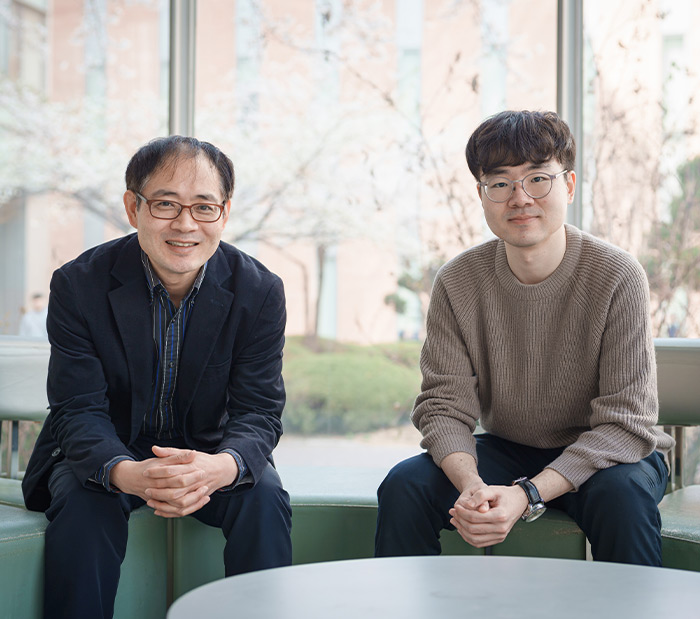
Chemistry LEE, JINYONG Prof. ·Ph. D. Jong Hyeon Lim
Wavelength engineerable porous organic polymer photosensitizers with protonation triggered ROS generation
The research team led by Prof. Jin Yong Lee of the Department of Chemistry (co-first author Ph. D. Jong Hyeon Lim) has developed a new porous organic photosensitizer (PS) system, KUP-1 for photodynamic therapy (PDT) through collaborative research with research teams led by Prof. Sungnam Park (Korea University), Prof. Dokyoung Kim (Kyung Hee University), Prof. Jong Seung Kim (Korea University), and Prof. Chang Seop Hong (Korea University). The research was published online in Nature Communications (IF: 17.694) in March 2023 under the title "Wavelength engineearable porous organic polymer photosensitizers with protonation triggered ROS generation. Although PDT is the most attractive and promising non-invasive therapy for cancer and microbial infection treatment, since several stages are involved in energy transfer process from the excitation of PS to the generation of reactive oxygen species (ROS), its ROS generation efficiency can lead to a significant variation with even slight changes in the excitation wavelength. Therefore, it is a challenge to adjust the excitation wavelength conditions of PS maintaining high ROS generation efficiency, which is also necessary to improve the therapeutic efficiency of PDT. The KUP system developed in this study is an imidazolium-based porous organic polymer material via cost-effective one-pot reactions. Remarkably, the optimal wavelength for maximum performance for generating ROS can be tuned by modifying the linker, despite the absence of metal ions and covalently attached heavy atoms. However, the detailed mechanism was not well understood, so Prof. Jin Yong Lee's group presented a theoretical basis for the experimental results showing that only ROS was generated in the protonated KUP system by comparing the relative rates of reactions that occur during the ROS generation process through non-adiabatic molecular dynamics (NAMD) simulations and density functional theory (DFT) calculations. They also confirmed that the adsorption energy between the protonated KUP system and oxygen molecule was higher than that of the neutral system. It is expected that the new PS developed in this study will contribute to the development of PDT for cancer treatment. *Title: Wavelength engineerable porous organic polymer photosensitizers with protonation triggered ROS generation.
- No. 219
- 2023-04-24
- 2575
-

Energy Science YOON, WON SUB Prof. ·Research Professor Wontae Lee and Professor Won-Sub Yoon
Recharge your life with caffeine,now as a energy storage materials
Research Professor Wontae Lee and Professor Won-Sub Yoon, at Sungkyunkwan University, report on the potential of caffeine as a cathode material for lithium-ion batteries for the first time. In addition, they identified the fact that high energy and fast charging speed can be secured according to the design of electrodes and molecules. The phenomenon of climate change felt on the skin has instilled a sense of crisis beyond lukewarm interest in environmental issues, and has further emphasized the importance of eco-friendly energy storage and conversion systems. Currently, cathode materials of lithium-ion batteries are mainly composed of transition metal-based inorganic compounds, and the amount of usage is further expanding with the blooming of the electric vehicle market. As a result, cost and sustainability concerns are growing due to finite and localized metal reserves. As an alternative to this, organic energy storage materials composed of elements abundant in nature, such as H, C, N, O, and S, are emerging. Caffeine (1,3,7-trimethylpurine-2,6-dione) is the most consumed psychoactive drug in modern society and is a xanthine alkaloid derivative. It is mainly contained in the coffee or tea we drink and shows the awakening effect. The researchers investigated the potential and reaction mechanism of caffeine as an energy storage material through an optimized electrode design. In this study, caffeine can store and release a total of 2 mol of lithium ions, and has a high capacity of more than 200 mAh/g even after 100 charge/discharge cycles. In addition, it shows fast charging, which is about 50% charged in 6 minutes. Furthermore, they identified the energy storage reaction mechanism of caffeine as an electrode material for lithium-ion batteries for the first time. However, Research Professor Wontae Lee added that there are still many issues to be solved in order to design electrodes at a commercial level due to the prototype electrode design designed for the purpose of analyzing the reaction mechanism. In addition, by showing that additional energy storage sites can be activated through molecular tuning of caffeine, the researchers demonstrate new possibilities for designing high-energy lithium-ion secondary batteries based on existing organic compound materials and suggest strategic directions. Research Professor Wontae Lee explained the research story with "When I was in graduate school, I saw a report in a medical paper that I came across by chance that caffeine consumption lowered the level of lithium-ion in the blood in addition to the wakefulness effect. At the time, without any basis, I started research with a simple thought, ‘If caffeine accepts lithium through an oxidation-reduction reaction, it can be used as an energy storage material’, but it was stopped because no practical results were obtained. However, with the passage of time, after receiving my Ph.D., I was able to actively conduct research with the support of the Sejong Science Fellowship and my advisor, Professor Won-Sub Yoon. Through the help of excellent researchers who accompanied me in this process, I was able to realize my vague imagination into reality.” Along with this, Professor Won-Sub Yoon said, “Currently, the main materials in the secondary battery market are inorganic compounds based on transition metals, such as high-content nickel-based layered materials. Due to their limited reserves, these metals will soon create problems such as high cost and sustainability concerns. As an alternative to this, although development is currently slower than transition metal-based materials in terms of commercialization, the development of organic electrode materials made of elements that exist infinitely in nature will be a very attractive strategy in terms of sustainable development." This research, conducted by Research Professor Wontae Lee and Professor Won-Sub Yoon of the Department of Energy Science, was selected as the exclusive front cover of 'Energy Storage Materials (IF 20.831, Top 2.54% in Materials Science, Q1)', a world-renowned academic journal in the field of materials science. (Volume 56/ 2023.02.17.) Energy storage mechanisms of caffeine molecules and strategies for activating new reaction sites through halogenation
- No. 218
- 2023-04-03
- 2883
-

Chemistry PARK, SUNGHO Prof.
The research team led by Prof. Sungho Park A new way to confine electromagnetic near-field within a single entity
Noble metals such as Au and Ag exhibit unique optical properties when their sizes are smaller than the wavelength of light. Surface plasmon resonance, a collective oscillation of conduction free electrons of metallic nanoparticles, is very sensitive to size, shape and dielectric environment and supports strong localized near-field confinement around the metallic nanoparticles. These plasmonic nanoparticles have been widely applied in a myriad of applications including optics, biosensing, catalysis and energy. Although structural-simple nanospheres or nanorods have been extensively used because of their easy-to-use, weak near-field focusing capabilities hindered their effective use for practical applications. In addition, nanoframes that have recently been paid attention show certain limitations in that their large inner spaces do not allow effective interactions with resonant light. Importantly, it is very challenging to produce nanoparticles with uniform size and shape via wet-chemical synthesis because diverse particle-particle interactions are present in a solution-phase. The research team (Nanomaterials Chemistry Lab.) led by Prof. Sungho Park in the department of chemistry, came up with a new idea inspired by ‘Cosmic Bowl*’ and ‘Matryoshka Doll**’and developed a new synthetic method for structurally very complex nanoframes that exhibit strongly enhanced near-field focusing capability. By suggesting a new paradigm in the field of nanoparticle synthesis, the research team’s breakthrough has been appreciated. The team applied rationally-designed multiple chemical steps and realized structural-complex nanoframes with different shapes, sizes, and numbers of nanogaps in a single entity. Importantly, the synthesis method is “rational and on-demand that is different from the conventional “trial-and-error” method, allowing for developing a broad library of unique nanoframes including dimensions (2D, and 3D), order (numbers of frames: 1st, 2nd, 3rd, and 4th), composition (Au, Pt, and Ag), shapes (circular, triangular, hexagonal, cubic, and octahedron), nanogaps shapes (circular, triangular, Y-shape) Using these nanoframes as a building block, the team fabricated superlattice substrates with uniform arrangement and high sensitivity. Their strong plasmonic interactions from inter- and intraparticle coupling allow for a very sensitive SERS-based detection of target molecules and reached pico and attomolar levels of limit of detection. Prof. Sungho Park said, “I am really happy and excited that we developed a new synthetic pathway for designing complex nanoframes that had never been reported before. We believe it is an important step towards new breakthroughs in nanoparticle synthesis and will use nanoframe-based libraries for diverse applications such as chemical/biological sensing, catalysis, plasmonics and energy storage where strong electromagnetic near-field enhancement is important.” This research was supported by the Challengeable Future Defense Technology Research and Development Program through the Agency for Defense Development (ADD) funded by the Defense Acquisition Program Administration (DAPA) in 2022. The results were published in various top-tier journals in the chemistry and materials science discipline, proving the scientific importance. (Nature Communications, Journal of the American Chemical Society, Accounts of Chemical Research, ACS Nano, Nano Letters, etc.) *(Title : Plasmonic All-Frame-Faceted Octahedral Nanoframes with Eight Engraved Y-Shaped Hot Zones, 제 1저자 : 김정원, 저널명 : ACS Nano (IF:18.027), 게재일 : 2022년 6월 28일) *(Title : All-Hot-Spot Bulk SERS substrates: Attomolar Detection of Adsorbates with Designer Plasmonic Nanoparticles, 제 1저자 : Qiang Zhao, 저널명 : Journal of American Chemical Society (IF:16.383), 게재일 : 2022년 7월 27일) *(Title : Three-dimensional Nanoframes with Dual Rims as Nanoprobes for Biosensing, 제 1저자 : Hajir Hilal, 저널명 : Nature Communications (IF:17.694), 게재일 : 2022년 8월 16일) *(Title : Synthesis of Pt Double-Walled Nanoframes with Well-Defined and Controllable Facets, 제 1저자 : MohammadNavid Haddadnezhad, 저널명 : ACS Nano (IF:18.027), 게재일 : 2022년 12월 27일) *(Title: Multi-Layered PtAu Nanoframes and their Light-Enhanced Electrocatalytic Activity via Plasmonic Hot Spots, 제 1저자 : 이수현 저널명 : Small (IF:15.153), 게재일 : 2023년 1월 8일) *(Title : Multiple Stepwise Synthetic Pathways toward Complex Plasmonic 2D and 3D Nanoframes for Generation of Electromagnetic Hot Zones in a Single Entity, 제 1저자 : 정인섭, 저널명 : Accounts of Chemical Research (IF:24.466), 게재일 : 2023년 2월 7일) *Cosmic Bowl: German mathematician and astronomer, Johannes Kepler proposed the concept of ‘Cosmic Bowl’ that the universe is interconnected by planets comprised of five platonic polygons nesting one in another. **Matryoshka Doll: A set of wooden dolls of decreasing size are nested one inside another and are known as Russian dolls. ※ Title : Multiple Stepwise Synthetic Pathways toward Complex Plasmonic 2D and 3D Nanoframes for Generation of Electromagnetic Hot Zones in a Single Entity (DOI: https://doi.org/10.1021/acs.accounts.2c00670) [Figure 1. 다단계의 2차원 복잡 구조 나노프레임 합성 모식도] [Figure 2. 이중-림을 가지는 나노프레임 합성법, 제작된 입자의 주사전자현미경 이미지 및 균일한 자가조립 기판의 극대화된 전자기장 증강 효과 시뮬레이션] [Figure 3. 금 나노입자 결정면의 에너지 차이를 이용한 선택적 백금 증착 및 금 에칭 기법을 활용하여 다양한 모양을 가지는 백금 기반의 단일 또는 이중림 구조 나노프레임 입자의 이미지] [Accounts of Chemical Research Journal, Feb. Supplementary cover] [ACS Nano Journal 2022 June Front cover]
- No. 217
- 2023-03-17
- 2619
-
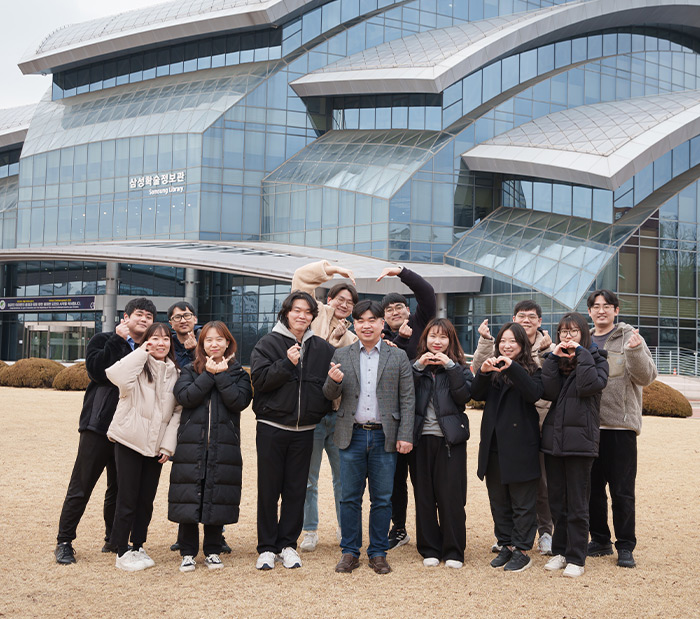
Electronic and Electrical Engineering SON, DONGHEE Prof.
A vacuum-deposited nanoscale ultrathin polymer dielectric for large-area stretchable electronics
The joint research team of assistant professor Donghee Son at Sungkyunkwan University (SKKU), professor Dae-Hyeong Kim at Seoul National University (SNU), and professor Sung Gap Im at Korea Advanced Institute of Science and Technology (KAIST) developed a soft, stretchable, nanometer-thick polymer dielectric film with exceptional thermal/chemical resistance through a initiated chemical vapor deposition (iCVD) process. The professor Son et al. applied the vacuum-deposited stretchable polymer film to intrinsically stretchable transistors and various logic gates in the 4-inch wafer scale. (Figure 1). Recently, various approaches for adopting soft materials have been developed for intrinsically stretchable electronics which does not need any specific structural designs owing to their deformability. However, such devices employed solution-processed dielectric materials and thereby encounter critical challenges in achieving high electrical performances. Specifically, solution-processed dielectric materials exhibit micrometer-scale thicknesses, low insulating performances, chemical instability, low uniformity, and incompatibility with conventional microfabrication processes. Such features result in low gate controllability, high operation voltages, and limited scalability to large-scale circuits. In this regard, the development of an ultrathin, stretchable, and high-performance dielectric material has remained a predominant goal in the field of intrinsically stretchable electronics. ▲Figure 1. A vacuum-deposited nanoscale ultrathin polymer dielectric for large-area stretchable electronics In the current study, we present a new approach to the design of dielectric materials to resolve the aforementioned challenges in intrinsically stretchable electronic devices. Our large-scale vacuum-deposited stretchable dielectric enables the scalable fabrication of intrinsically stretchable devices with electrical performances comparable to those fabricated using the non-stretchable inorganic and stretchable organic dielectric materials (e.g., Al2O3 deposited via atomic layer deposition & spin-coated viscoelastic layer). Such high performance allows for the fabrication of intrinsically stretchable transistors and logic circuits that operate with the lowest reported power consumption. We consider that the observations of our study would transform the conventional paradigm of soft electronics. To realize the vacuum-deposited polymer dielectric, its fabrication started with copolymerizing two different monomers, isononyl acrylate (INA) and 1,3,5-trimethyl-1,3,5-tryvinyl cyclotrisiloxane (V3D3) through an initiated chemical vapor deposition (iCVD). The INA acts as a soft segment that provides stretchability and V3D3 serves as a cross-linkable hard segment, giving the polymer film robust insulating properties. The mixing ratio of the monomers (INA and V3D3) was optimized to achieve both insulating and stretching performance of the device. In this study, the world’s 1st vacuum-deposited polymer film with both elasticity and insulation properties even at a ultra-thin thickness of approximately 100 nanometers enabled by optimal combination of soft monomer and crosslinker was developed (Figure 2). ▲Figure 2. A vacuum-deposited nanoscale ultra-thin stretchable polymer dielectric film with large-area uniformity, thermal/chemical stability enabled by copolymerization in iCVD process The joint team demonstrated the wafer-scale fabrication/integration process using iCVD film. As-fabricated stretchable transistors consisting of a network-structured semiconducting carbon nanotubes (CNTs), microcrack-based stretchable metal electrodes (e.g. gate, source, and drain) featured field-effect mobility of 14.05 cm2/Vs at 10 μm channel length, subthreshold swing (SS) of 265 mV/dec, threshold voltage (Vth) of 2.47 V, and log (Ion/Ioff) of 4.63 while showing operational uniformity and stretching stability. ▲Figure 3. Wafer-scale integration of stretchable electronics using an iCVD polymer dielectric The iCVD stretchable dielectric broke the existing technical barrier of conventional organic dielectric that could not combine stable insulating performance and stretchability with submicron thickness, achieving the highest output drive current in the same channel area, which was enabled by nanoscale ultra-thin thickness-derived high capacitance and low-voltage operational property (Fig. 4). Professor Donghee Son said "We think achieving the energy-efficient performance of the stretchable electronic devices is the most important issue in the long-term reliable wearables. In this regard, we innovatively overcame the limitation of conventional flexible organic dielectric materials, which were major bottlenecks in the field of stretchable electronics technology, by demonstrating large-area integration of low-power stretchable electronic devices using vacuum-deposited nanoscale-thick ultra-thin polymer dielectric with thermal/chemical stability." SKKU-SNU-KAIST joint research team published on the paper on Feburary 3rd(Fri) on the electronic engineering department of international journal called (Nature Electronics, IF: 33.255, JCR 0.18%) This study was allowed with the support from Ministry of Science and ICT-Directorate for Basic Research in Science & Engineering, Institute for Basic Science(IBS-R006-A1 and IBS-R015-D1), National Research Foundation of Korea Basic Research in Science & Engineering(2021R1I1A1A01060389), Samsung Science & Technology Foundation(SRFC-IT2102-04). ※ Title: A vacuum-deposited polymer dielectric for wafer-scale stretchable electronics ※ DOI: https://doi.org/10.1038/s41928-023-00918-y
- No. 216
- 2023-03-03
- 3074
-
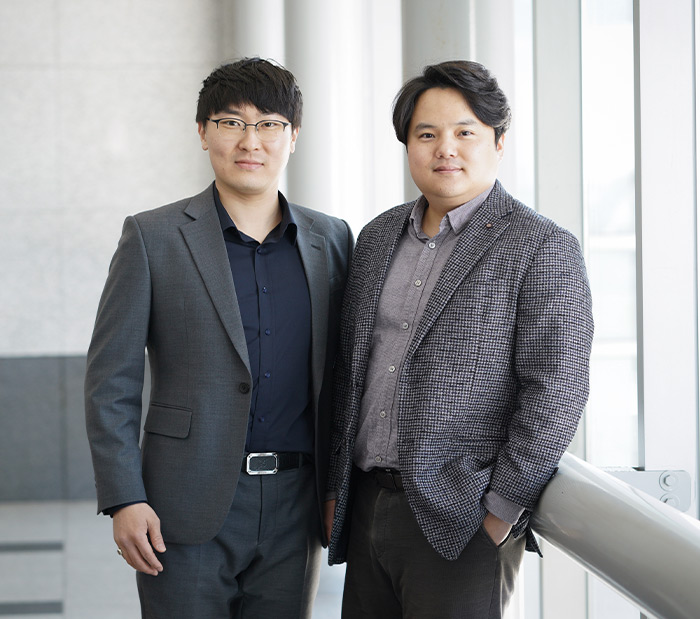
SKKU Advanced Institute of Nano Technology AN, SEONGPIL Prof. ·SAINT faculty Seongpil An and Il Jeon co-research team
Development of a highly transparent and multifunctional wearable nanogenerator
Piezoelectric nanogenerators (PENGs) that harvest electrical energy from ubiquitous mechanical motions have recently attracted significant attention as a environmentally friendly next-generation energy harvesting technology that does not rely on fossil fuels. Unlike previous research, the PENG developed this time includes excellent transparency and mechanical durability, expected to be widely applicable in various industries. In particular, since the PENG that produces electrical energy through body motions can be used as a self-powered high-sensitivity motion detecting sensor, which is expected to be used in the field of next-generation healthcare wearable electronic devices. Profs. Seongpil An and Il Jeon’s co-research team from SKKU Advanced Institute of Nanotechnology (SAINT) announced that they have developed a multifunctional transparent composite that can harvest energy, composed of piezoelectric polymer nanofibers and high-purity carbon nanotubes (CNTs) as the core materials. In previous studies, silver nanowires or electrically conductive polymers, such as PEDOT:PSS, were used as electrodes for transparent PENGs. However, metal-based transparent PENGs have inherent issues of opacity due to their natural light reflection and scattering, while electrically conductive polymer-based PENGs have shown material limitations in mechanical properties with insufficient electrical conductivity. The co-research team developed a multifunctional transparent composite capable of harvesting energy using a silicon-based elastomer embedded with piezoelectric polymer nanofibers and high-purity CNTs. The team developed piezoelectric P(VDF-TrFE) nanofibers with a diameter of 500 nm, 200 times thinner than a human hair, using the electrospinning technique and embedded them in a transparent sisilicon-basedlastomer PDMS. They also used a differentiated aerosol-assisted chemical vapor deposition (CVD) method to produce transparent CNT films for their use as electrodes in the development of a transparent PENG. The electrospinning and aerosol CVD methods used in this study are not only simple to use but also easily scalable to larger production scales compared to other methods. Based on these excellent process advantages, it is expected to have a positive impact on the commercialization of related technologies in the future. In particular, in this study, the conductivity of the CNT electrode could be improved by 3.1 times through a simple chemical doping method. The developed high-transparency PENG demonstrated decent energy harvesting performance that generated a voltage of 10 V or more even with relatively weak external force (F = 10 N). Additionally, it showed high energy harvesting performance under repetitive external force conditions of over 50,000 cycles, proving excellent mechanical durability and stability. Furthermore, when the external force was applied through a body part, such as fingers, it exhibited higher energy harvesting performance of up to 26.8 V through an additional effect of triboelectricity. It is expected that the newly developed transparent PENG can be applied extensively in the rapidly growing fields of metaverse, virtual/augmented reality, as it can not only detect subtle movements of the human body in real time by attaching it to various parts of the body, but also generate voltage signals sensitively in response to changing external forces. Prof. An said, “At SAINT, young professors who are actively engaged in research activities have formed a close relationship of solidarity, and joint research is being carried out in various directions. This research achievement is one of the results of such collaborative efforts, and it is expected to lead to more innovative research outcomes in the future.” In addition, Prof. Jeon said that “This joint research was an impressive opportunity for two research groups with different strengths to integrate their expertise into a new research field. Prof An's research team could understand [CNT-based transparent conductive electrodes] while my team could work on [PENG devices], which opened up a new avenue for expanding our research areas.” The lead author of the study, doctoral student Kiyong Kim said, “There is infinite potential for improving the energy harvesting performance of PENGs, and research should be conducted from various perspectives in the future.” The co-first author doctoral student Sangsu Lee added, “This study is the first report on the use of CNTs as electrodes in a nanogenerator, and we hope it will provide a new direction for research on transparent nanogenerators.” This study was supported by the Basic Science Research Program (2021R1F1A1061404) and the New Faculty Research Fund (2021R1C1C1009200) through the National Research Foundation of Korea (NRF). This study was published on January 18th in Advanced Functional Materials (IF: 19.924), a world-renowned academic journal in the top 5% of the material science field, based on the results that won the SKKU Graduate Student Paper Award. The lead authors of this paper are beginner in doctoral course, so their future research activities are highly anticipated. ※ Title: Highly Transparent and Mechanically Robust Energy-harvestable Piezocomposite with Embedded 1D P(VDF-TrFE) Nanofibers and Single-walled Carbon Nanotubes (Journal Advanced Functional Materials, https://onlinelibrary.wiley.com/doi/10.1002/adfm.202213374) ▲Transparent PENG developed and its fabrication process ▲ Results of energy harvesting and sensing performances
- No. 215
- 2023-02-27
- 2131
-
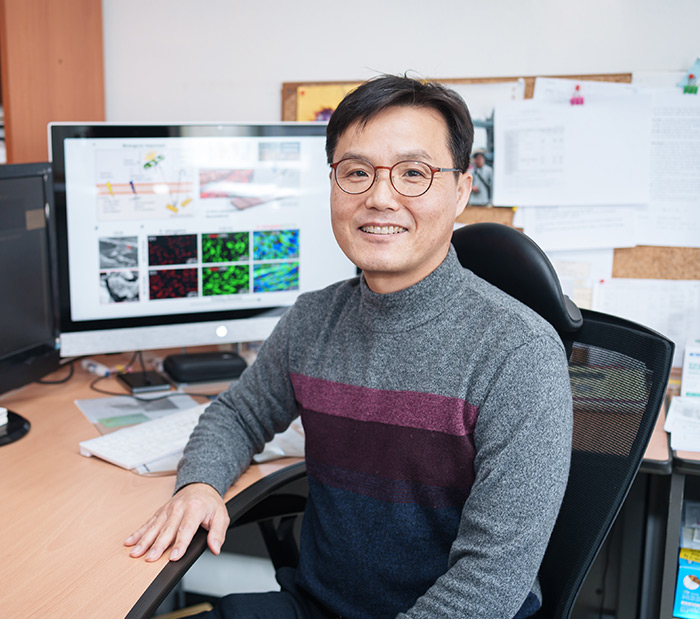
Bio-Mechatronic Engineering KIM, GEUNHYUNG Prof. ·Dr. Hyeongjin Lee, Mr. Hanjun Hwangbo
Employment of photosynthetic bacterium for hypoxia prevention and efficient myogenesis in muscle tissue regeneration
Inadequate oxygen delivery to the macroscale 3D cell-constructs of regenerating skeletal muscle tissue has remained a multiplex issue owing to the pivotal factors such as cell metabolism and several regulatory intercellular pathways that eventually influence various cellular activities and determines cell phenotype. In addition, continuous metabolic activities of cells in 3D bioconstructs could evoke accumulation of reactive oxygen species (ROS) and induce cellular damage via oxidative stresses. To overcome this issue, the research team led by professor Geun Hyung Kim in Biomechatronic engineering department has developed oxygen-generating cyanobacteria-laden bioink and utilized in situ E-field assisted bioprinting system to rescue the cells in 3D printed constructs from hypoxic conditions for regenerating skeletal muscle tissue. Various factors such as cyanobacteria concentrations, LED light exposure and E-field were considered to optimize the developed system. As result, owing to the synergistic effects of the bioactive microenvironment that rescues cells from hypoxic conditions and activations of voltage-gated ion channels, highly aligned, multi-nucleated myofibers are obtained as well as significant upregulation (7–10-fold) of myogenic-related genes compared with conventionally prepared cell-constructs. Prof Kim states, "Based on these promising results, the combined effects of oxygen-generating cyanobacteria as a bioactive constituent of the bioink and simultaneous E-field-supporting bioprinting can offer an effective treatment strategy against severe skeletal muscle defects." To add, he states, “unlimited to muscle tissues, it can also be used as an effective artificial organ production system for various tissue regeneration which requires oxygen supply.” The described study was published in Advanced Functional Materials (IF = 19.924) in December of 2022 under support from the National Research Foundation of Korea (NRF) funded by the Ministry of Science and ICT for Bioinspired Innovation Technology Development Project (NRF-2018M3C1B7021997) and grant from the Ministry of Trade, Industry & Energy (MOTIE, Korea) under Industrial Technology Innovation Program (20009652, Technology on commercialization and materials of Bioabsorbable Hydroxyapatite less than 1 micrometer in size). ※Paper: Photosynthetic Cyanobacteria can Clearly Induce Efficient Muscle Tissue Regeneration of Bioprinted Cell-Constructs (https://doi.org/10.1002/adfm.202209157). Figure 1. Schematic diagrams of printing process and biological response of cells to in situ E-field stimulation and oxygen-generating cyanobacteria.
- No. 214
- 2023-02-15
- 2157
-
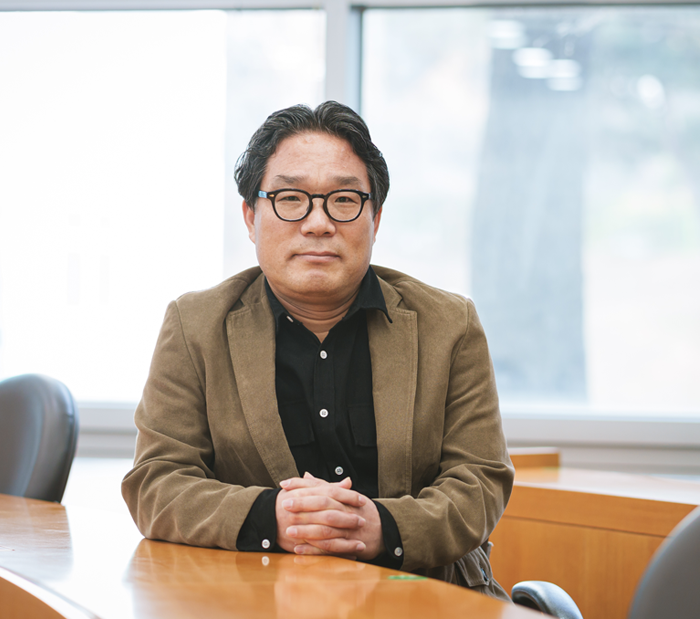
SKKU Advanced Institute of Nano Technology LIM, YONGTAIK Prof. ·Seung Mo Jin, Yeon Jeong Yoo
Overcoming the limitations of antitumor immunotherapy by developing K-nanoadjuvant
Prof. Yong Taik Lim’s research team (SAINT) developed the world’s first kinetically activating nanoadjuvant (K-nanoadjuvant), which enables therapeutic immune cells to generate effective antitumor immunity without exhaustion. The research results were published in Nature Nanotechnology (IF: 39.213), a world-renowned academic journal in the field of multidisciplinary science. Various drugs capable of effective innate immune induction, such as toll-like receptor (TLR) agonists, have been developed throughout the history of oncology. Although these drugs contribute to immune activation, they also cause immunotoxicity and exhaustion of immune cells, resulting in ineffective cancer immunotherapy overall. To address these issues, researchers designed a nanoliposome-based novel TLR7/8a (timely activating TLR7/8 agonist; t-TLR7/8a) for the first time and revealed the efficacy of K-nanoadjuvant fabricated in combination with various TLR agonists. A nanoliposome-based K-nanoadjuvant is a novel immune function-modulating platform that not only maximizes immune cell activation but also overcomes immune cell exhaustion induced by excessive immune responses. Such effect was achieved by coordinating optimized time, order, and combinatorial code of two different immunostimulants with different mechanisms of action which induce different signal transduction routes. K-nanoadjuvant solves the problem of current immunostimulants and has a high potential for clinical application, as previous research has proven the safety of nanoliposome-based platforms in the human body. Researchers expect K-nanoadjuvant to be applied to immune checkpoint inhibitors unresponsive patient group, the latest anticancer therapeutic drug, and can be used as a next-generation anticancer therapeutic drug that can prevent recurrence/metastasis.
- No. 213
- 2023-01-13
- 2871
-
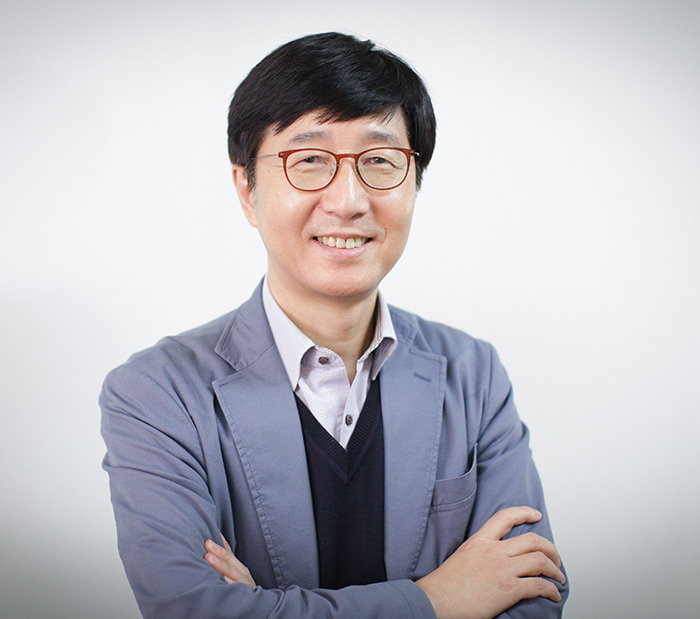
Chemical Engineering PARK, NAM-GYU Prof.
Discovery of Photovoltaically Top-performing Perovskite Crystal Facets
Prof. Nam-Gyu Park (Department of Chemical Engineering) and his coworkers Dr. Chunqing Ma, Prof. Seok Jun Kwon, and Prof. Cheol-Woong Yang discovered photovoltaically top-performing perovskite crystal facets. Presently, the non-uniformly crystallization of the perovskite thin film is still a major constraint for high-performance and stable perovskite devices, resulting in high defect density, complex surface morphology, and so forth. More importantly, the rough morphology of perovskite thin film hinders the study of the facet properties, which is considered a crucial factor for interface property and device performance. Therefore, the effective preparation of perovskite thin films containing single crystals with well-defined facets is extremely urgent for the enhancement of perovskite device performances and the understanding of the facet properties. The achieved perovskite single crystal-assembled thin film in this work can significantly reduce the defect density induced by the non-uniformly crystallization, leading to a stable perovskite solar cell with a PCE of 24.64%. The well-defined facets on the thin film also provide a platform for the study of facet heterogeneity, which directly proves the photovoltaically top-performing (100) and (111) facets. Discovering the top-performing facets of perovskite crystals holds the secret to highly efficient perovskite solar cells (PSCs). Yet, the dominant facet properties of perovskite (i.e. (100), (110), (111) facets) remain elusive because perovskite grains typically exhibit randomly oriented domains and buried facets. Here, we demonstrate that exquisite control of the perovskite film formation enables perovskite polyhedral single crystals with well-defined facets and thereby provides a platform for the subsequent study of facet heterogeneity. Three dominated facets of (100), (111), and (110) on the perovskite film are studied experimentally and theoretically. It is found that facets with variant densities and symmetries of atoms govern the perovskite surface chemical and electronic environment and generate significant effects on the carrier dynamic, optoelectronic properties, as well as photovoltaic performance. Carrier mobility and photocurrent of the (100) crystal facet are almost comparable to those of the (111) facets, which is much higher than those of the (110) one. With the perovskite single crystal assembled thin film, the PSC achieves a quasi-steady-state (QSS) efficiency of 24.64% with improved stability to light. Our work not only suggests a strategy for designing single crystals assembled perovskite film, but also provides a deep understanding of the optoelectronic properties of halide perovskite facets. [Figure] (Top) Schematic cubic crystal structure and SEM images showing crystal facets. (Bottom) Photocurrent depending on crystal facets and stability of perovskite solar cell depending on crystal facets of the perovskite films ※ Paper Title : Photovoltaically top-performing perovskite crystal facets
- No. 212
- 2023-01-10
- 2761
-

Sociology LEE, HAENA Prof.
Children Exposed to Lead may Experience Symptoms of Dementia Sooner
Prof. Haena Lee and colleagues published a study in Science Advances (IF: 14.14) on the long-term impact of childhood lead exposure on cognitive functioning in later life. The study, one of the first to investigate the decades-long consequences of lead poisoning, suggests countries could face an explosion of people seeking support for dementia as individuals who were exposed to high lead levels during early life progress into old age. Although scientists have long known that children and adults who are exposed to lead have poorer cognitive and educational outcomes, few studies have investigated the longer-term consequences. Lee and her colleagues combined data from the US-based longitudinal Health and Retirement Study (HRS), which has followed the cognitive health of thousands of adults over several decades, with census records to pinpoint where 1,089 of these individuals lived as children. They also mapped the locations of towns and cities that used lead pipes and had acidic or alkaline water – a proxy for lead exposure. The research revealed that people who lived in cities with lead-contaminated water as children had worse baseline cognitive functioning – a measure of their ability to learn, process information, and reason – at age 72, compared with those who did not. The difference was equivalent to being roughly eight years older. Although childhood lead exposure doesn’t necessarily mean a person is at greater risk of dementia, the authors suggest that they may experience cognitive impairment earlier as they start out at a substantially lower point. The team found no difference in the rate of cognitive decline between the two groups – possibly because their cognitive function was tested after any brain damage due to lead exposure had taken place. Prof. Lee said, “More research is clearly and urgently needed to better understand the lifelong implications of childhood lead exposure for brain aging and to identify effective interventions to mitigate lead’s long-term consequences.” This research has collaborated with Prof. John Robert Warren (Sociology, University of Minnesota), Dr. Mark Lee (Minnesota Population Center, University of Minnesota), and Prof. Joseph Ferrie (Economics, Northwestern University). The Guardian article on this research can be found here: https://www.theguardian.com/society/2022/nov/09/children-exposed-to-lead-may-experience-symptoms-of-dementia-sooner-study Please visit the website for more information. DOI: 10.1126/sciadv.abn5164
- No. 211
- 2022-12-28
- 2567
